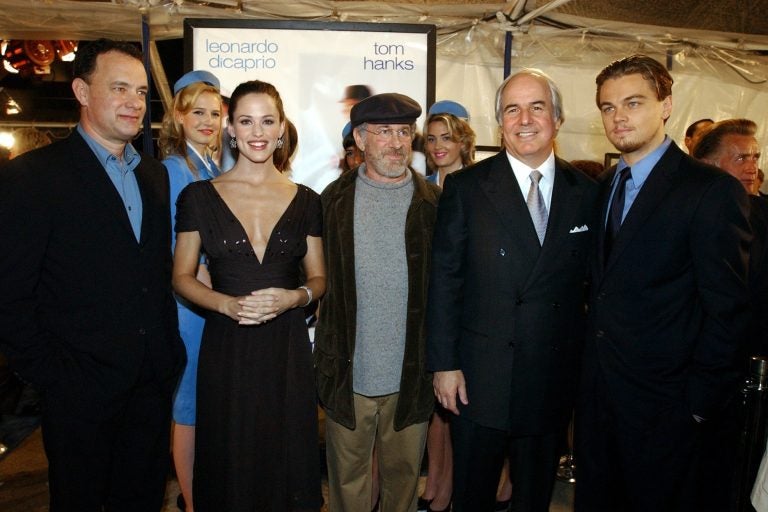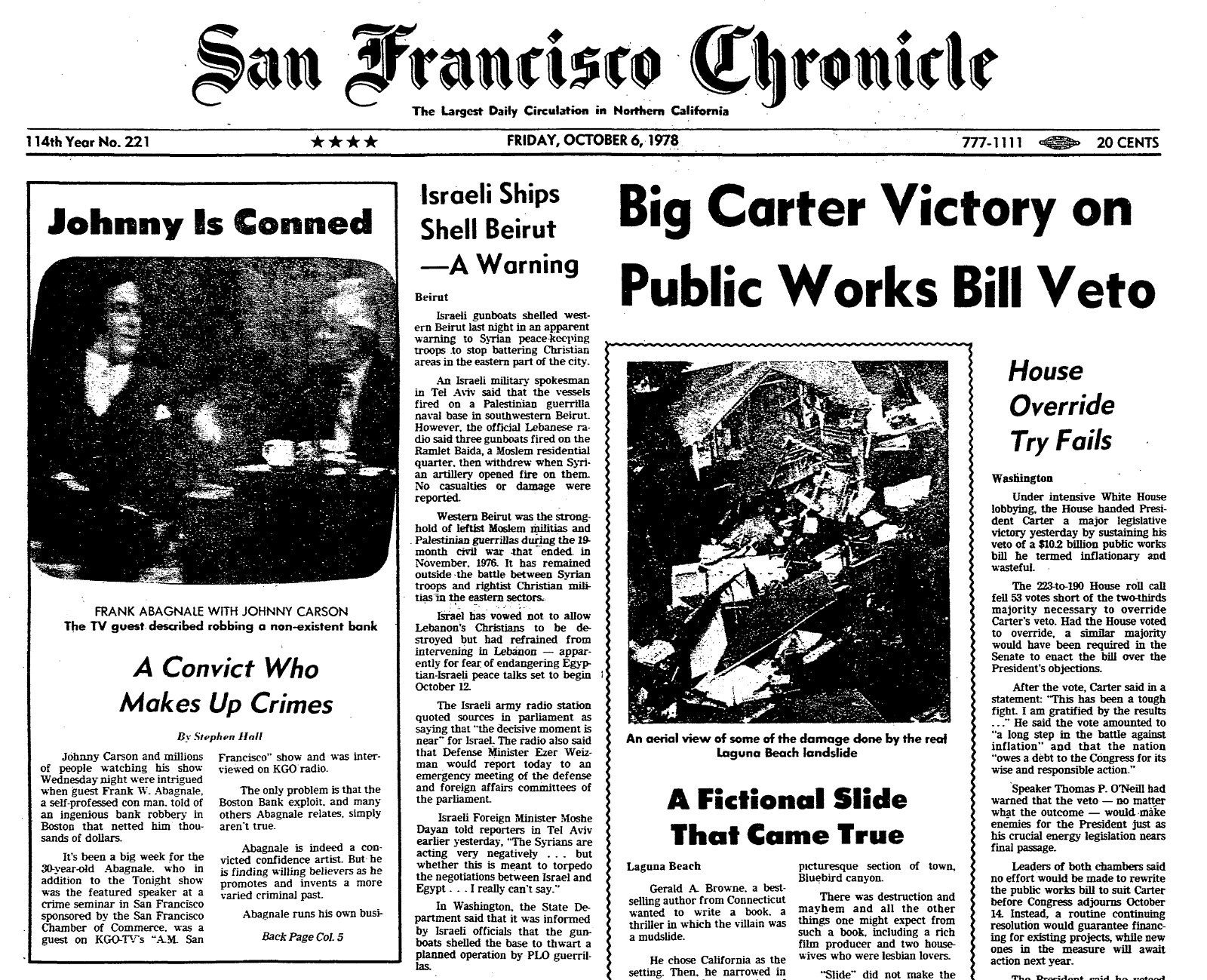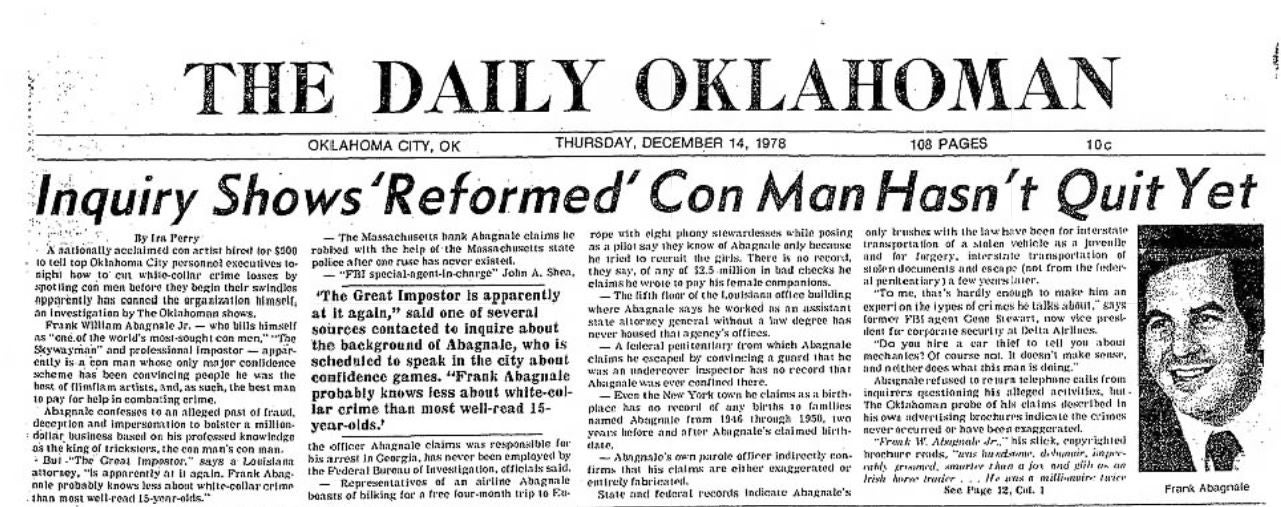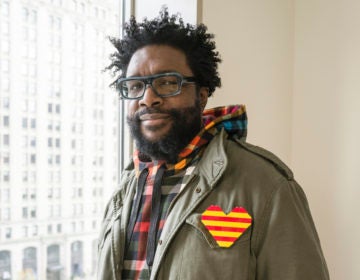Could this famous conman be lying about his story? A new book suggests he is
Frank W. Abagnale Jr. is famous for cons documented in the blockbuster “Catch Me If You Can.” But science writer Alan Logan says the real grift is Abagnale’s entire story.
Listen 10:23
Frank W. Abagnale Jr. (second from the right) is famous for his audacious cons, documented in the blockbuster movie “Catch Me If You Can.” But science writer Alan Logan says the real grift is Abagnale’s entire life story. (Rene Macura/AP Photo)
This story is from The Pulse, a weekly health and science podcast.
Subscribe on Apple Podcasts, Spotify or wherever you get your podcasts.
Frank W. Abagnale Jr. may have pulled off one of the greatest hoaxes on earth.
Abagnale’s famous tale of forging checks and assuming different professional identities has captured national audiences through pop-culture adaptations, most famously the 2002 Steven Spielberg film, “Catch Me if You Can,” starring Leonardo DiCaprio and Tom Hanks. It was developed from Abagnale’s memoir of the same name.
The story goes that between the mid-1960s and the early 1970s, Abagnale lived out many lives as an impostor. He pretended to be a pilot for Pan American airlines, a doctor in Georgia, a lawyer for the attorney general’s office in Baton Rouge, Louisiana, and a professor at Brigham Young University. He also cashed more than $2 million worth of bad checks in over 26 countries. All this, he claimed, while still a teenager and while being chased by the FBI.
The movie was a hit, winning tons of awards and garnering many more nominations.
But though the movie claims to be based on a true story, creating the myth of Frank W. Abagnale Jr. might be the best con that Abagnale actually pulled. A new book contends that the story of the charming teen running from the FBI and pulling off all those impersonations without getting caught is mostly made up.
Science journalist Alan C. Logan remembers watching the film on videocassette after it came out and thinking that there was just something off about it.
“I remember just having this nagging feeling and that something just wasn’t quite right about it,” Logan said. “And that was that. That thought, you know, went into the back of my mind for a couple of decades almost.”
Logan eventually revisited that nagging feeling. In early 2020, he wrote a book about Robert Vernon Spears, a medical conman who was the suspect in a mysterious commercial airline disaster in 1959.
“And everyone who read the book started comparing Spears, who was verifiable … to Abagnale, to ‘Catch Me if You Can.’ And I just thought, well, let me look into [it] a little bit. And nothing was adding up, nothing was verifiable.”
Logan said what he found blew his mind. His book about it is called “The Greatest Hoax on Earth: Catching Truth, While We Can.”
The real Frank
Logan used public records and newspaper clippings to find out the real story. He even spoke to people who knew Abagnale before the myth about his life took off, including a flight attendant Abagnale met in 1969 in an encounter that eventually led to his incarceration.
“What really happened was that, dressed as a TWA (Trans World Airlines) pilot, which he only did for a few weeks, [Abagnale] befriended a flight attendant called Paula Parks,” Logan said. “He followed her all over the Eastern Seaboard, identified her work schedule through deceptive means, and essentially stalked the woman.”
Parks didn’t know what to do with him. She tried to tell him that she wasn’t interested, but he was persistent. He even showed up at her apartment in New Orleans. She told him then that she was going to go visit her parents in Baton Rouge, and he tagged along.
“So Frank Abagnale meets her parents in Baton Rouge. Frank and Paula … part ways, and a few days later, Frank Abagnale shows back up at [her parents’] house in Baton Rouge and said, ‘Hey, I’m Paula’s friend. Remember me? I’m on furlough as a pilot.’ And they invited him in out of kindness.”
Abagnale stayed with the family for a while, in Parks’ room, and she was mortified. She didn’t trust him, but her family did. They cooked meals for him, and introduced him to people in Baton Rouge. He would take the family out to dinner and buy them flowers, earning their trust. All the while he was doing that with checks he stole from them, which he had rifled through. He stole about $1,200 from the family, and more from local businesses in Baton Rouge. In his book, Abagnale claimed that he never ripped off individuals, only hotels, airlines and banks.
Eventually, he was caught and arrested.
“So Abagnale’s narrative that between the ages of 16 and 20, he was on the run, chased all over the United States and even internationally by the FBI. This is completely fictitious,” Logan said. “Public records obtained by me show that he was confined for the most part in prison during those years.”
To tell the lie
Abagnale was paroled in 1974, and moved to Friendswood, Texas, where he was arrested once again for theft. After Abagnale got out of prison, a parole officer encouraged him to tell his story of being a transformed man.
It was an idea Abagnale ran with. At first, he started by giving small lectures, telling this story of redemption, but his tale grew larger and larger. He teamed up with a producer and eventually landed an appearance in 1977 on a national television show called “To Tell The Truth.”
The premise of the show was that celebrity panelists had to identify the one person who was not lying, out of three people claiming to be the same person. Logan said there was no fact-checking on “To Tell The Truth.”
“And perhaps for the first time in this show’s history, you had three liars on the stage. Two of them were instructed to lie. And then Abagnale told multiple lies about his biography on that show.”
Once Abagnale was on “To Tell The Truth,” he was a hit. The game show led to further opportunities on national TV. Later that same year, he was featured on the “Today” show with Tom Brokaw. Soon after, he was on “The Tonight Show” with Johnny Carson.
While most people were mesmerized by the story of the conman who impersonated a pilot, a doctor, a lawyer, and a college professor, some were not as convinced.
Subscribe to The Pulse
Local journalism to the rescue
“There is amazing journalism in 1978,” Logan said. “Stephen Hall, as a rookie journalist working for the San Francisco Chronicle, saw Abagnale on ‘The Tonight Show’ in 1978 and started to query some of the claims.”
For example, Abagnale described stealing money from a deposit drop at Logan Airport dressed as a security guard, with the help of two Massachusetts state troopers.
Hall investigated, and debunked the story.

Two months later, another journalist took on the Abagnale tale. Ira Perry, a reporter for The Daily Oklahoman, did a line-by-line debunking of the story when Abagnale was scheduled to visit Oklahoma City for one of his talks.
Perry investigated some of Abagnale’s bigger claims, including that he recruited young women at the University of Arizona to tour Europe with him on Pan Am’s dime and that he stole $2.5 million from them through bad checks. The scene with the flight attendants was dramatized in the movie version.
When Perry asked Pan Am spokesperson Bruce Haxthausen about the company’s financial losses, he denied that Abagnale had ever stolen the money.
“I’ve checked with the security people and everyone here, and it never happened,” Haxthausen told Perry. “This is the first we’ve heard of this, and we would have heard or at least remember[ed] it if it had happened. You don’t forget $2.5 million in bad checks. I’d say this guy is as phony as a $3 bill.”

And while Hall and Perry were able to unravel the story behind some of Abagnale’s claims, his rising star overshadowed those claims.
“Much like Stephen Hall, Ira Perry was a rookie journalist up for a challenge and did just really stunning research that really helped me in my quest,” Logan said. “Now, the problem in the pre- digital era, the San Francisco Chronicle piece by Hall and The Daily Oklahoman piece by Ira Perry didn’t really go anywhere. It just stayed locally in the environment. And Abagnale was still hopping, skipping and jumping all over the country and selling it and getting onto shows.”
The legacy of Frank W. Abagnale Jr.
Logan writes that these articles debunking Abagnale’s claims were no more than a little speed bump in his rise to fame. Abagnale was asked to come back to “The Tonight Show” multiple times after his first appearance. And, when asked about the journalism claiming to have debunked his stories, Abagnale responded that those people the journalists spoke to were too embarrassed to admit that they had been conned.
Abagnale went on to write a best-selling book, which was then adapted into both the Spielberg film and a Broadway play. Those adaptations further legitimized Abagnale’s larger-than-life tales.
“When the movie comes out, you have major Hollywood players,” Logan said. “These are not … C-level actors. You’re talking about the elites, the most famous director of all time, with A-level Hollywood celebrities playing the roles. So think about how that would then translate. It’s got to be true because there’s no way it couldn’t be.”
Logan said Abagnale has even used the shield of the FBI to legitimize his story.
“No one from the FBI has ever made a public statement about what Abagnale has or hasn’t done for them,” Logan said. “He has given some guest lectures at the academy, but he makes these outlandish statements in the media. He’s claimed to teach ethics at the FBI.”
Abagnale sticks by his stories, continuing to tell and retell them even today.
“Go to YouTube, you will see the Talks at Google that Abagnale did not that long ago. That video has been viewed over 11 million times. And he makes the claim there, still, that he was an attorney general and passed the bar exam.”
In the video, Abagnale claims that the FBI included in its 100th anniversary coffee table book a section that identifies him as the only person ever sprung out of the federal penitentiary to work for the agency.
“And I just recently … picked up a copy. There is, indeed, a beautiful coffee table book printed and published by the FBI. And Mr. Abagnale’s name, as you might suspect, is nowhere to be found within it.”
Logan said Abagnale’s story and his book are especially relevant now, encapsulating the problem of today’s “post-truth” society. A problem that is often exacerbated by social media.
“You have seen ample evidence of the rapid speed at which misinformation is spread,” Logan said. “Especially when you see certain celebrities endorsing conspiracy theories, then you [begin] to see legitimacy and information spreads even farther, relying on what feels true as opposed to things that are verifiable. … [It] makes it harder to understand where the truth sits.”
This story holds a lesson for the times we live in, Logan said: People should try to practice reflective thinking; they shouldn’t just believe everything they hear, but should instead interrogate unlikely claims that may come their way.
“Because I think many people, when they step back from this story and really take a breath and really think it through, ‘Is it possible that all this happened according to the narrative?’ And, it’s just not, it’s not plausible,” he said. “And so reflective thinking is something, I think, that is of extreme value to society right now.”
Alan Logan is the author of “The Greatest Hoax on Earth: Catching Truth, While We Can.“
We reached out to Frank W. Abagnale Jr. for a comment on this story. He emailed back saying: “I have not read the book, nor do I think it is worthy of a comment.”
WHYY is your source for fact-based, in-depth journalism and information. As a nonprofit organization, we rely on financial support from readers like you. Please give today.







